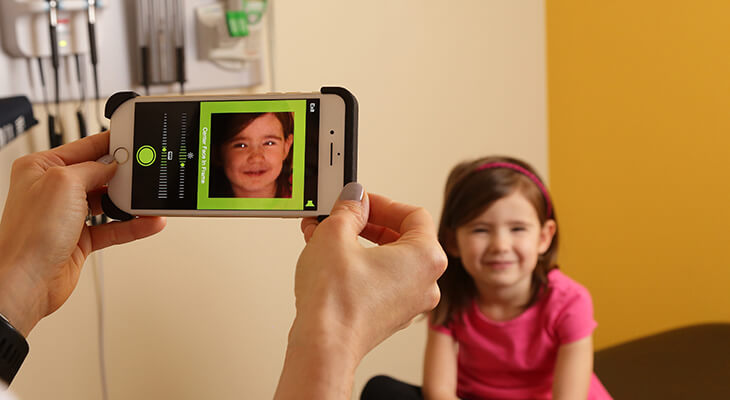[bt_section][bt_row][bt_column width=”1/1″][bt_hr top_spaced=”not-spaced” bottom_spaced=”bottomSmallSpaced” transparent_border=”border” el_class=”” el_style=””][/bt_hr][bt_hr top_spaced=”topSmallSpaced” bottom_spaced=”bottomSmallSpaced” transparent_border=”border” el_class=”” el_style=””][/bt_hr][bt_text]
Pediatricians at Norton Children’s Medical Associates practices are using customized iPhones to detect serious eye problems, including amblyopia – lazy eye – and some types of eye cancer, such as retinoblastoma, in children age 6 and younger.
“Detecting these issues in young kids has always been tough, because children don’t want to stay still and can’t communicate vision problems,” said April R. Mattingly, M.D., pediatrician at Norton Children’s Medical Associates – Crestwood. “Some of these issues keep kids from seeing well in the classroom, but others can lead to surgery or vision loss if not caught early enough.”
How GoCheck Kids works
When your pediatrician walks into the exam room during your child’s annual wellness visit, he or she will have a customized iPhone in hand equipped with the GoCheck Kids app. The doctor will aim the iPhone at your child — zooming in on the eyes — and take a photo. The camera’s flash will bounce light off the back of the retina to capture the “red reflex,” which is commonly known in photos as “red eye.” The GoCheck Kids app then detects your child’s pupil location and runs an algorithm.
Within a couple of seconds, the app pulls up a reading of your child’s eyes and makes note of any deformities or irregularities. The report also is automatically saved in your child’s medical file and can be shared with other doctors, if needed.
“The process is very quick and efficient, which makes both the patients and their parents very happy,” Dr. Mattingly said. “And it allows us to determine if more evaluation is needed.”
App can replace standard eye chart for older kids
The conventional eye exam has for years involved covering one eye and reading the smallest line of letters possible from 20 feet away. For children age 8 and under, GoCheck Kids turns the eye test into an interactive game involving moving and matching letters on the phone. At the end of the game, you receive a visual score and a list of any potential risk factors.
“This is a fun change from the standard eye test,” Dr. Mattingly said. “Most children are used to playing games on phones or tablets, so they’re more engaged and enjoy the process.”
It’s also more convenient.
“Using standard eye charts typically involves the patient standing in the middle of a hallway, which can create challenges for other patients and staff,” Dr. Mattingly said. “Now we can perform eye exams without leaving the exam room. It’s a win for everyone.”
[/bt_text][bt_hr top_spaced=”topSmallSpaced” bottom_spaced=”bottomSmallSpaced” transparent_border=”noBorder” el_class=”” el_style=””][/bt_hr][/bt_column][/bt_row][/bt_section]



